Development of Stiff, Tough and Conductive Composites by the Addition of Graphene Nanoplatelets to Polyethersulfone/Epoxy Composites
Abstract
:1. Introduction
2. Experimental
2.1. Materials
2.2. Composites Fabrication
2.3. Characterization
3. Results and Discussion
3.1. Characterization of GnPs and Dispersion of GnPs in Matrix
3.2. Tensile and Flexural Properties
3.3. Dynamic Mechanical Properties
3.4. Thermal Conductivity
3.5. Fracture Toughness, Morphology, and Failure Mechanisms
4. Conclusions
Author Contributions
Funding
Conflicts of Interest
References
- White, K.L.; Sue, H.J. Electrical conductivity and fracture behavior of epoxy/polyamide-12/multiwalled carbon nanotube composites. Polym. Eng. Sci. 2011, 51, 2245–2253. [Google Scholar] [CrossRef]
- Zaman, I.; Manshoor, B.; Khalid, A.; Meng, Q.S.; Araby, S. Interface modification of clay and graphene platelets reinforced epoxy nanocomposites: A comparative study. J. Mater. Sci. 2014, 49, 5856–5865. [Google Scholar] [CrossRef]
- Hsu, Y.G.; Liang, C.W. Properties and behavior of CTBN-modified epoxy with IPN structure. J. Appl. Polym. Sci. 2007, 106, 1576–1584. [Google Scholar] [CrossRef]
- Lee, S.E.; Jeong, E.; Lee, M.Y.; Lee, M.K.; Lee, Y.S. Improvement of the mechanical and thermal properties of polyethersulfone-modified epoxy composites. J. Ind. Eng. Chem. 2016, 33, 73–79. [Google Scholar] [CrossRef]
- Yun, N.G.; Won, Y.G.; Kim, S.C. Toughening of epoxy composite by dispersing polysulfone particle to form morphology spectrum. Polym. Bull. 2004, 52, 365–372. [Google Scholar] [CrossRef]
- Zhang, J.; Xie, X.M. Influence of addition of silica particles on reaction-induced phase separation and properties of epoxy/PEI blends. Compos. Part A 2011, 48, 2163–2169. [Google Scholar] [CrossRef]
- Xi, J.J.; Yu, Z.Q. Toughening mechanism of rubber reinforced epoxy composites by thermal and microwave curing. J. Appl. Polym. Sci. 2018, 135, 45767. [Google Scholar] [CrossRef]
- Li, F.; Hua, Y.; Qu, C.B.; Xiao, H.M.; Fu, S.Y. Greatly enhanced cryogenic mechanical properties of short carbon fiber/polyethersulfone composites by graphene oxide coating. Compos. Part A 2016, 89, 47–55. [Google Scholar] [CrossRef]
- Jiang, M.Q.; Liu, Y.; Cheng, C.; Zhou, J.L.; Liu, B.H.; Yu, M.H.; Zhang, H. Enhanced mechanical and thermal properties of monocomponent high performance epoxy resin by blending with hydroxyl terminated polyethersulfone. Polym. Test. 2018, 69, 302–309. [Google Scholar] [CrossRef]
- Chikhi, N.; Fellahi, S.; Bakar, M. Modification of epoxy resin using reactive liquid (ATBN) rubber. Eur. Polym. J. 2002, 38, 251–264. [Google Scholar] [CrossRef]
- Wang, F.Z.; Drzal, L.T.; Qin, Y.; Huang, Z.X. Enhancement of fracture toughness, mechanical and thermal properties of rubber/epoxy composites by incorporation of graphene nanoplatelets. Compos. Part A 2016, 87, 10–22. [Google Scholar] [CrossRef]
- Wang, Y.; Zhang, B.M.; Ye, J.R. Microstructures and toughening mechanisms of organoclay/polyethersulphone/epoxy hybrid nanocomposites. Mat. Sci. Eng. A Struct. 2011, 528, 7999–8005. [Google Scholar] [CrossRef]
- Koh, K.L.; Ji, X.B.; Dasari, A.; Lu, X.H.; Lau, S.K.; Chen, Z. Fracture toughness and elastic modulus of epoxy-based nanocomposites with dopamine-modified nano-fillers. Materials 2017, 10, 776. [Google Scholar] [CrossRef] [PubMed]
- Zhang, Y.; Song, P.A.; Fu, S.Y.; Chen, F.H. Morphological structure and mechanical properties of epoxy/polysulfone/cellulose nanofiber ternary nanocomposites. Compos. Sci. Technol. 2015, 115, 66–71. [Google Scholar] [CrossRef]
- Kausar, A.; Iqbal, A.; Hussain, S.T. Preparation and properties of polyamide/epoxy/multi-walled carbon nanotube nanocomposite. J. Plast. Film Sheet. 2014, 30, 205–224. [Google Scholar] [CrossRef]
- Hussein, S.I.; Abd-Elnaiem, A.M.; Asafa, T.B.; Jaafar, H.I. Effect of incorporation of conductive fillers on mechanical properties and thermal conductivity of epoxy resin composite. Appl. Phys. A Mater. 2018, 124, 475. [Google Scholar] [CrossRef]
- Nioua, Y.; EI Bouazzaoui, S.; Melo, B.M.G.; Prezas, P.R.S.; Graça, M.P.F.; Achour, M.E.; Costa, L.C.; Brosseau, C. Analyzing the frequency and temperature dependences of the ac conductivity and dielectric analysis of reduced graphene oxide/epoxy polymer nanocomposites. J. Mater. Sci. 2017, 52, 13790–13798. [Google Scholar]
- Du, X.; Skachko, I.; Barker, A.; Andrei, E.Y. Approaching ballistic transport in suspended graphene. Nat. Nanotechnol. 2008, 3, 491–495. [Google Scholar] [CrossRef] [PubMed] [Green Version]
- Lee, C.; Wei, X.; Kysar, J.W.; Hone, J. Measurement of the elastic properties and intrinsic strength of monolayer graphene. Science 2008, 321, 385–388. [Google Scholar] [CrossRef] [PubMed]
- Drzal, L.T.; Fukushima, H. Expanded Graphite and Products Produced Therefrom. U.S. Patent US 8501858 B2, 17 May 2006. [Google Scholar]
- Zhang, G.W.; Wang, F.Z.; Dai, J.; Huang, Z.X. Effect of functionalization of graphene nanoplatelets on the mechanical and thermal properties of silicone rubber composites. Materials 2016, 9, 92. [Google Scholar] [CrossRef] [PubMed]
- Kalaitzidou, K.; Fukushima, H.; Drzal, L.T. Multifunctional polypropylene composites produced by incorporation of exfoliated graphite nanoplatelets. Carbon 2007, 45, 1446–1452. [Google Scholar] [CrossRef]
- Li, Y.; Zhang, H.; Porwal, H.; Huang, Z.H.; Bilotti, E.; Peijs, T. Mechanical, electrical and thermal properties of in-situ exfoliated graphene/epoxy nanocomposites. Compos. Part A 2017, 95, 229–236. [Google Scholar] [CrossRef]
- Domun, N.; Paton, K.R.; Hadavinia, H.; Sainsbury, T.; Zhang, T.; Mohamud, H. Enhancement of fracture toughness of epoxy nanocomposites by combining nanotubes and nanosheets as fillers. Materials 2017, 10, 1179. [Google Scholar] [CrossRef] [PubMed]
- Bhasin, M.; Wu, S.Y.; Ladani, R.B.; Kinloch, A.J.; Wang, C.H.; Mouritz, A.P. Increasing the fatigue resistance of epoxy nanocomposites by aligning graphene nanoplatelets. Int. J. Fatigue 2018, 113, 88–97. [Google Scholar] [CrossRef]
- Wang, F.Z.; Drzal, L.T.; Qin, Y.; Huang, Z.X. Processing and characterization of high content multilayer graphene/epoxy composites with high electrical conductivity. Polym. Compos. 2016, 37, 2897–2906. [Google Scholar] [CrossRef]
- Wang, F.Z.; Drzal, L.T.; Qin, Y.; Huang, Z.X. Mechanical properties and thermal conductivity of graphene nanoplatelets/epoxy nanocomposites. J. Mater. Sci. 2015, 50, 1082–1093. [Google Scholar] [CrossRef]
- Chandrasekaran, S.; Sato, N.; Tölle, F.; Mülhaupt, R.; Fiedler, B.; Schulte, K. Fracture toughness and failure mechanism of graphene based epoxy composites. Compos. Sci. Technol. 2014, 97, 90–99. [Google Scholar] [CrossRef]
- Stankovich, S.; Dikin, D.A.; Dommett, G.H.; Kohl-haas, K.M.; Zimney, E.J.; Stach, E.A.; Piner, R.D.; Nguyen, S.T.; Ruoff, R.S. Graphene-based composite materials. Nature 2006, 442, 282–286. [Google Scholar] [CrossRef] [PubMed]
- Chhetri, S.; Adak, N.C.; Samanta, P.; Murmu, N.C.; Kuila, T. Functionalized reduced graphene oxide/epoxy composites with enhanced mechanical properties and thermal stability. Polym. Test. 2017, 63, 1–11. [Google Scholar] [CrossRef]
- Hou, W.X.; Gao, Y.; Wang, J.; Blackwood, D.J.; Teo, S. Nanodiamond decorated graphene oxide and the reinforcement to epoxy. Compos. Sci. Technol. 2018, 165, 9–17. [Google Scholar] [CrossRef]
- Wei, Y.; Hu, X.Y.; Jiang, Q.R.; Sun, Z.Y.; Wang, P.F.; Qiu, Y.P.; Liu, W.S. Influence of graphene oxide with different oxidation levels on the properties of epoxy composites. Compos. Sci. Technol. 2018, 161, 74–84. [Google Scholar] [CrossRef]
- Stankovich, S.; Dikin, D.A.; Piner, R.D.; Kohlhaas, K.A.; Kleinhammes, A.; Jia, Y.; Wu, Y.; Nguyen, S.T.; Ruoff, R.S. Synthesis of graphene-based nanosheets via chemical reduction of exfoliated graphite oxide. Carbon 2007, 45, 1558–1565. [Google Scholar] [CrossRef]
- Rajasekaran, R.; Alagar, M.; Chozhan, C.K. Effect of polyethersulfone and N,N′-bismaleimido-4,4′-diphenyl methane on the mechanical and thermal properties of epoxy systems. Express Polym. Lett. 2008, 2, 339–348. [Google Scholar] [CrossRef] [Green Version]
- Xiao, W.K.; Zhai, X.; Ma, P.F.; Fan, T.T.; Li, X.T. Numerical study on the thermal behavior of graphene nanoplatelets/epoxy composites. Results Phys. 2018, 9, 673–679. [Google Scholar] [CrossRef]
- Li, A.; Zhang, C.; Zhang, Y.F. Thermal conductivity of graphene-polymer composites: Mechanisms, properties, and applications. Polymers 2017, 9, 437. [Google Scholar]
- Xiang, J.L.; Drzal, L.T. Thermal conductivity of exfoliated graphite nanoplatelet paper. Carbon 2011, 49, 773–778. [Google Scholar] [CrossRef]
- Yang, J.P.; Chen, Z.K.; Feng, Q.P.; Deng, Y.H.; Liu, Y.; Ni, Q.Q.; Fu, S.Y. Cryogenic mechanical behaviors of carbon nanotube reinforced composites based on modified epoxy by poly(ethersulfone). Compos. Part B 2012, 43, 22–26. [Google Scholar] [CrossRef]
- Wang, Y.; Ma, X.; Zhang, B.M. Preparation and properties of organoclay/polyethersulphone/epoxy hybrid nanocomposites. Polym. Compos. 2015, 36, 767–774. [Google Scholar] [CrossRef]
- Chouhan, D.; Rath, S.K.; Kumar, A.; Alegaonkar, P.S.; Kumar, S.; Harikrishnan, G.; Patro, T.U. Structure-reinforcement correlation and chain dynamics in graphene oxide and Laponite-filled epoxy nanocomposites. J. Mater. Sci. 2015, 50, 7458–7472. [Google Scholar] [CrossRef]
- Yu, G.J.; Wu, P.Y. Effect of chemically modified graphene oxide on the phase separation behaviour and properties of an epoxy/polyetherimide binary system. Polym. Chem. 2014, 5, 96–104. [Google Scholar] [CrossRef]
- Zheng, N.; Sun, W.F.; Liu, H.; Huang, Y.D.; Mai, Y.W. Effects of carboxylated carbon nanotubes on the phase separation behaviour and fracture-mechanical properties of an epoxy/polysulfone blend. Compos. Sci. Technol. 2018, 159, 180–188. [Google Scholar] [CrossRef]
- Velthem, P.V.; Ballout, W.; Horion, J.; Janssens, Y.A.; Destoop, V.; Pardoen, T.; Bailly, C. Morphology and fracture properties of toughened highly crosslinked epoxy composites: A comparative study between high and low Tg tougheners. Compos. Part B 2016, 101, 14–20. [Google Scholar] [CrossRef]
- Rafiee, M.A.; Rafiee, J.; Srivastava, I.; Wang, Z.; Song, H.; Yu, Z.Z.; Koratkar, N. Fracture and fatigue in graphene nanocomposites. Small 2010, 6, 179–183. [Google Scholar] [CrossRef] [PubMed]
- Kuo, W.S.; Tai, N.H.; Chang, T.W. Deformation and fracture in graphene nanosheets. Compos. Part A 2013, 51, 56–61. [Google Scholar] [CrossRef]
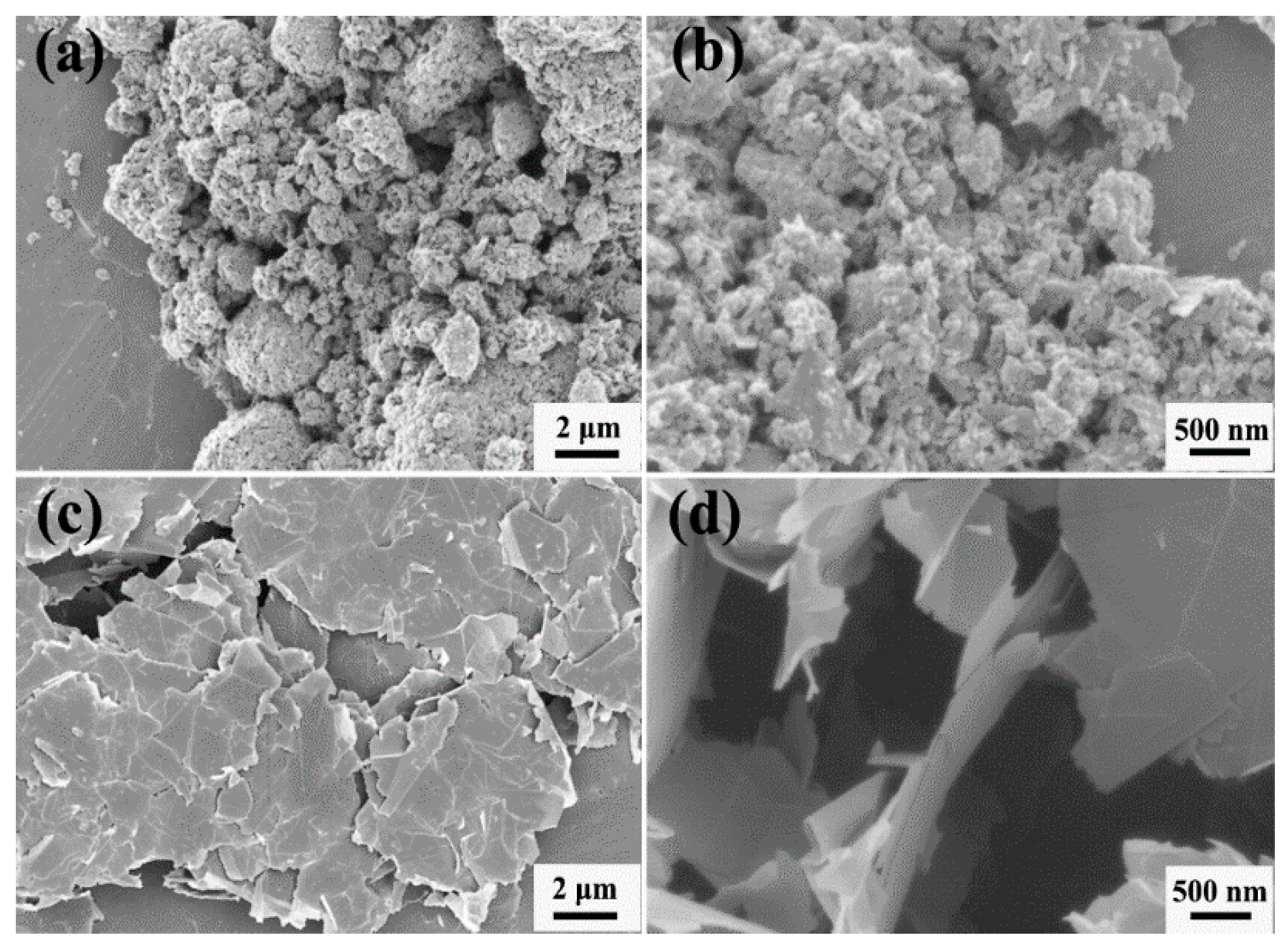
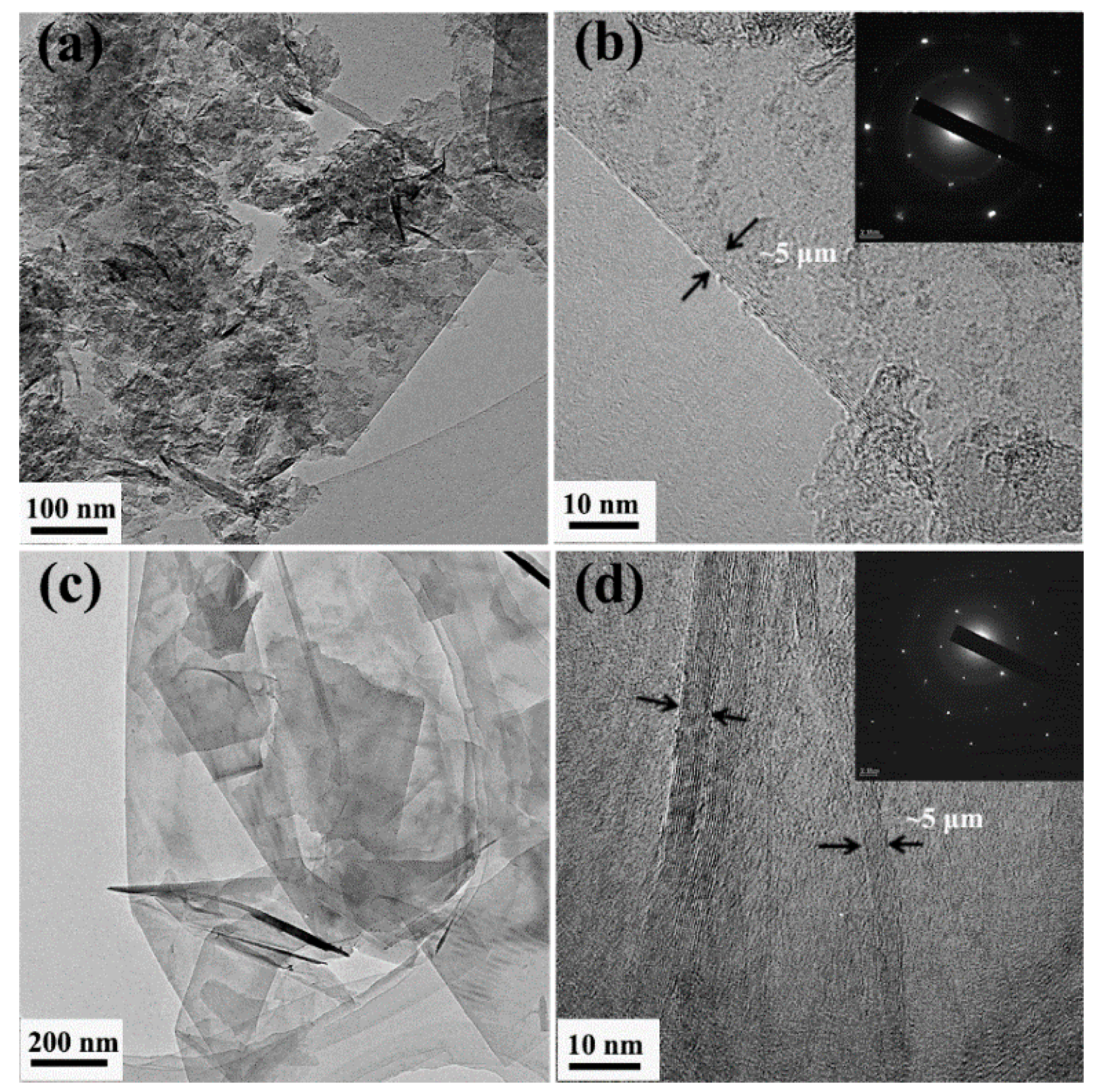
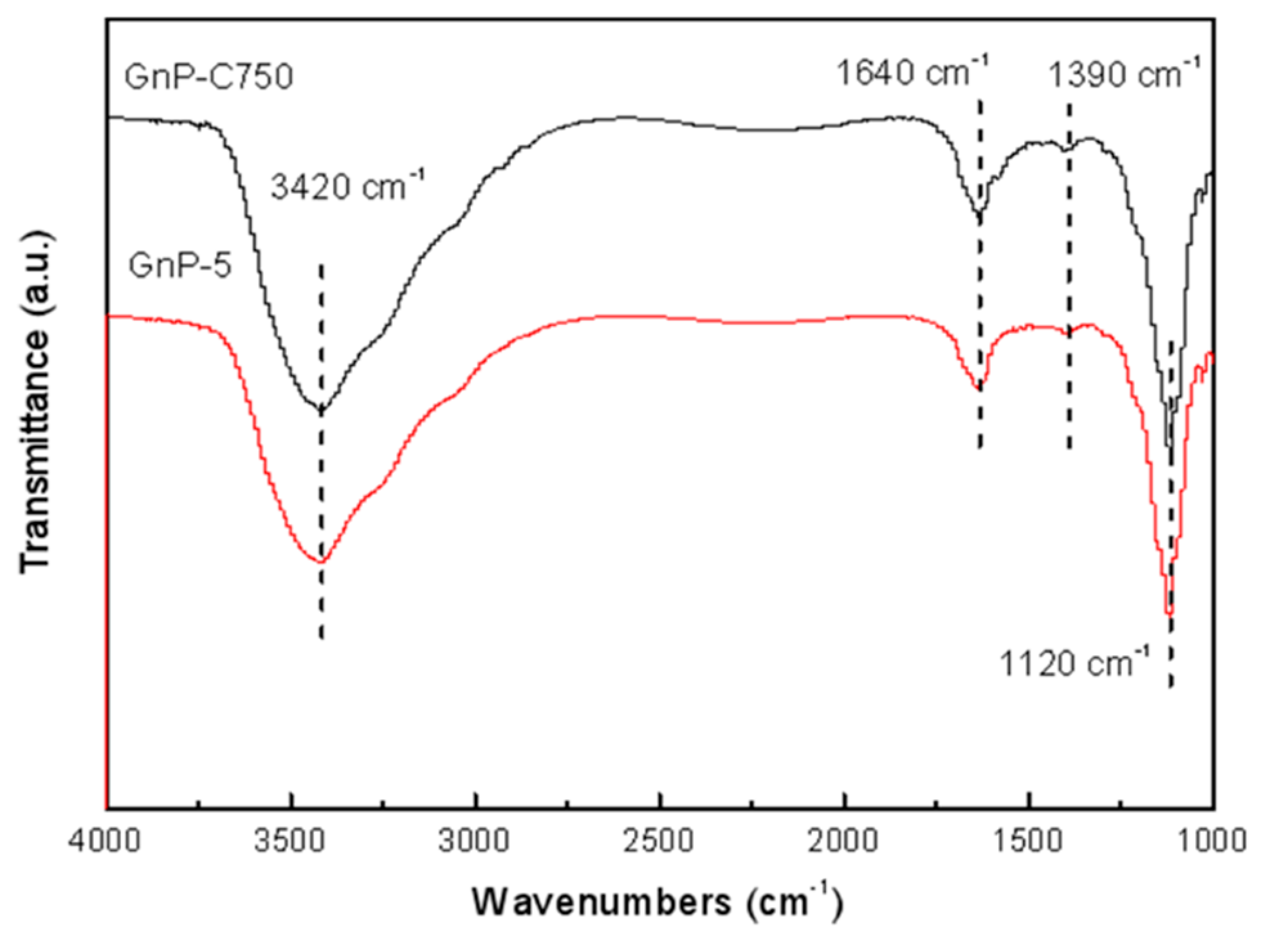
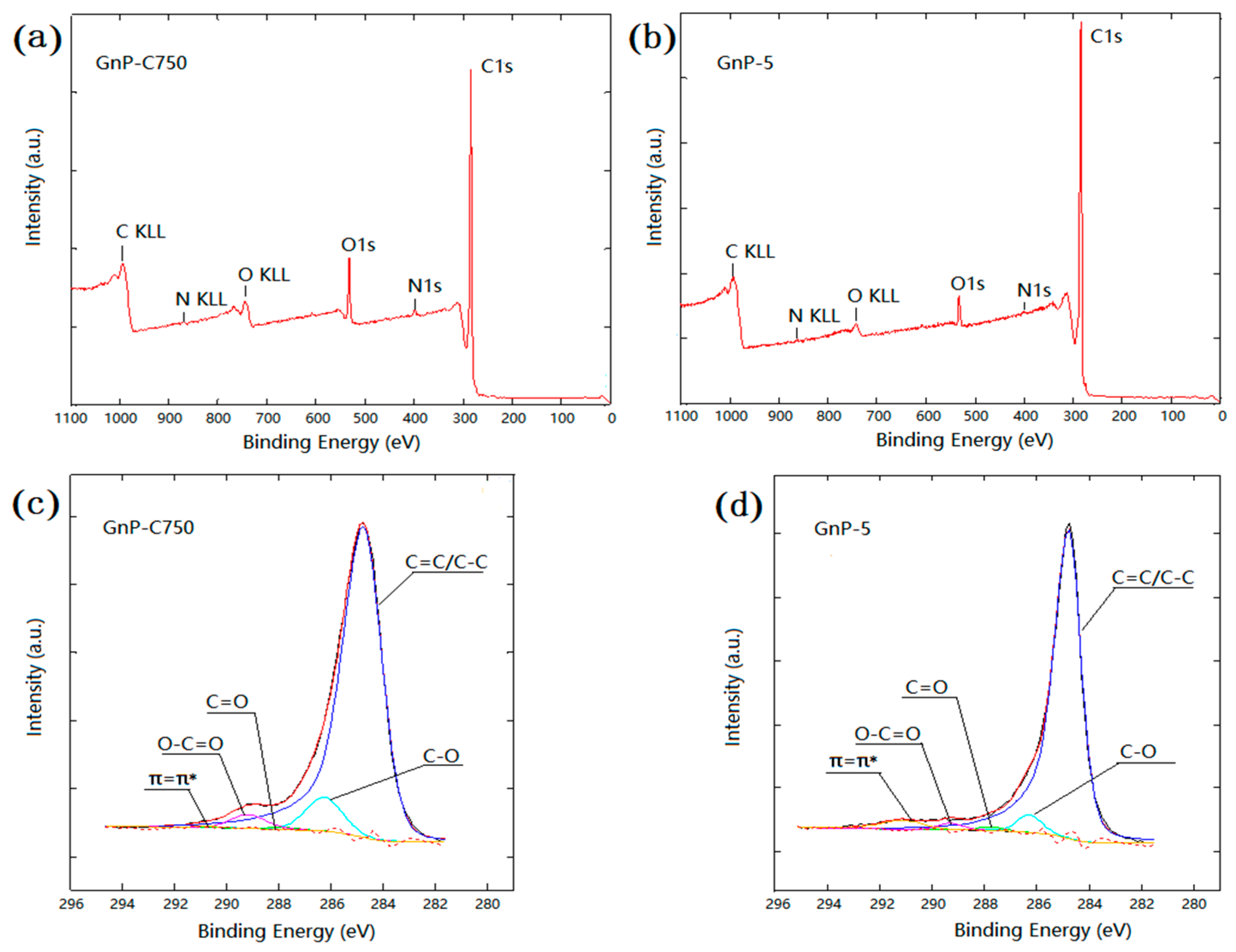
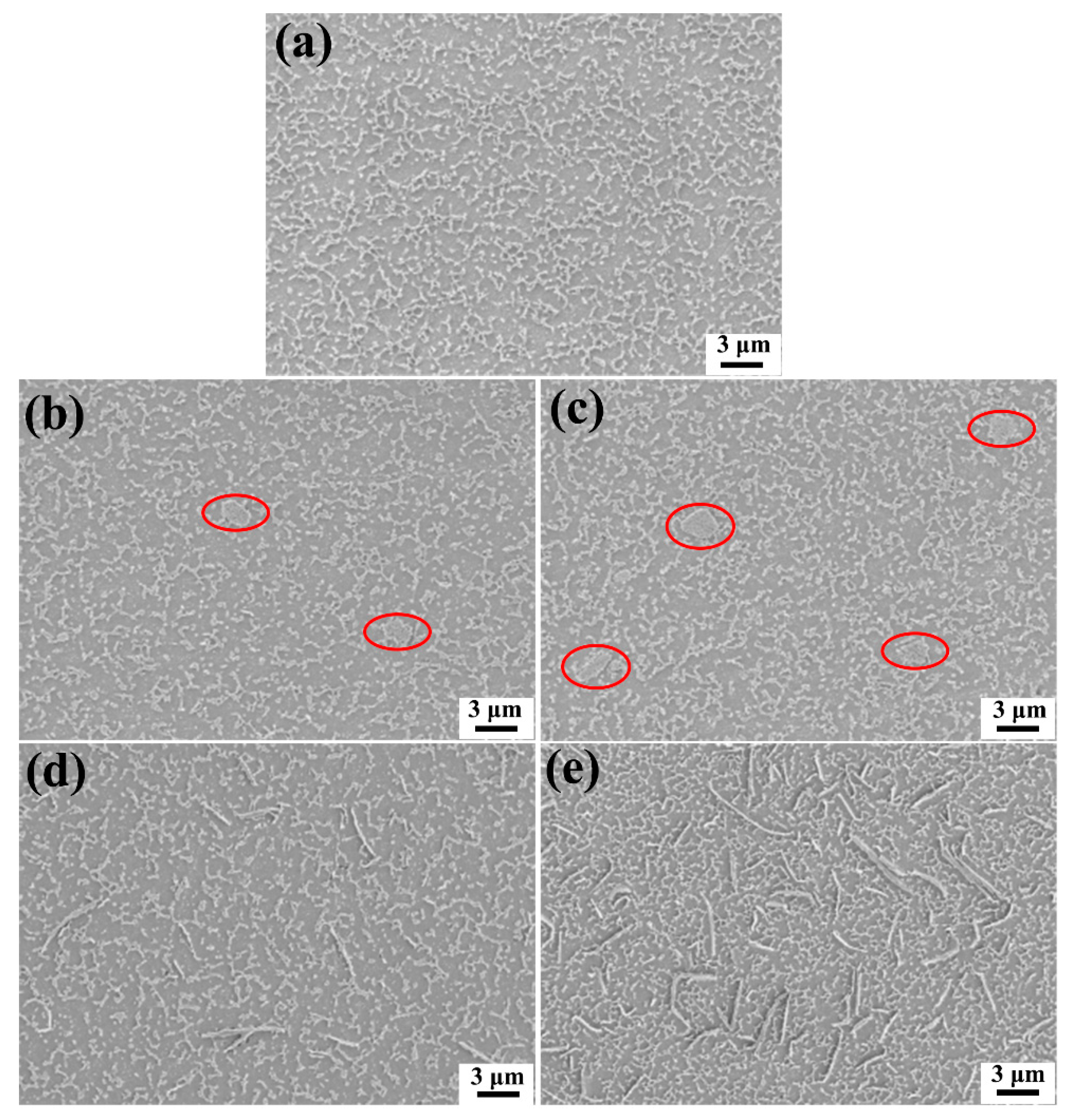

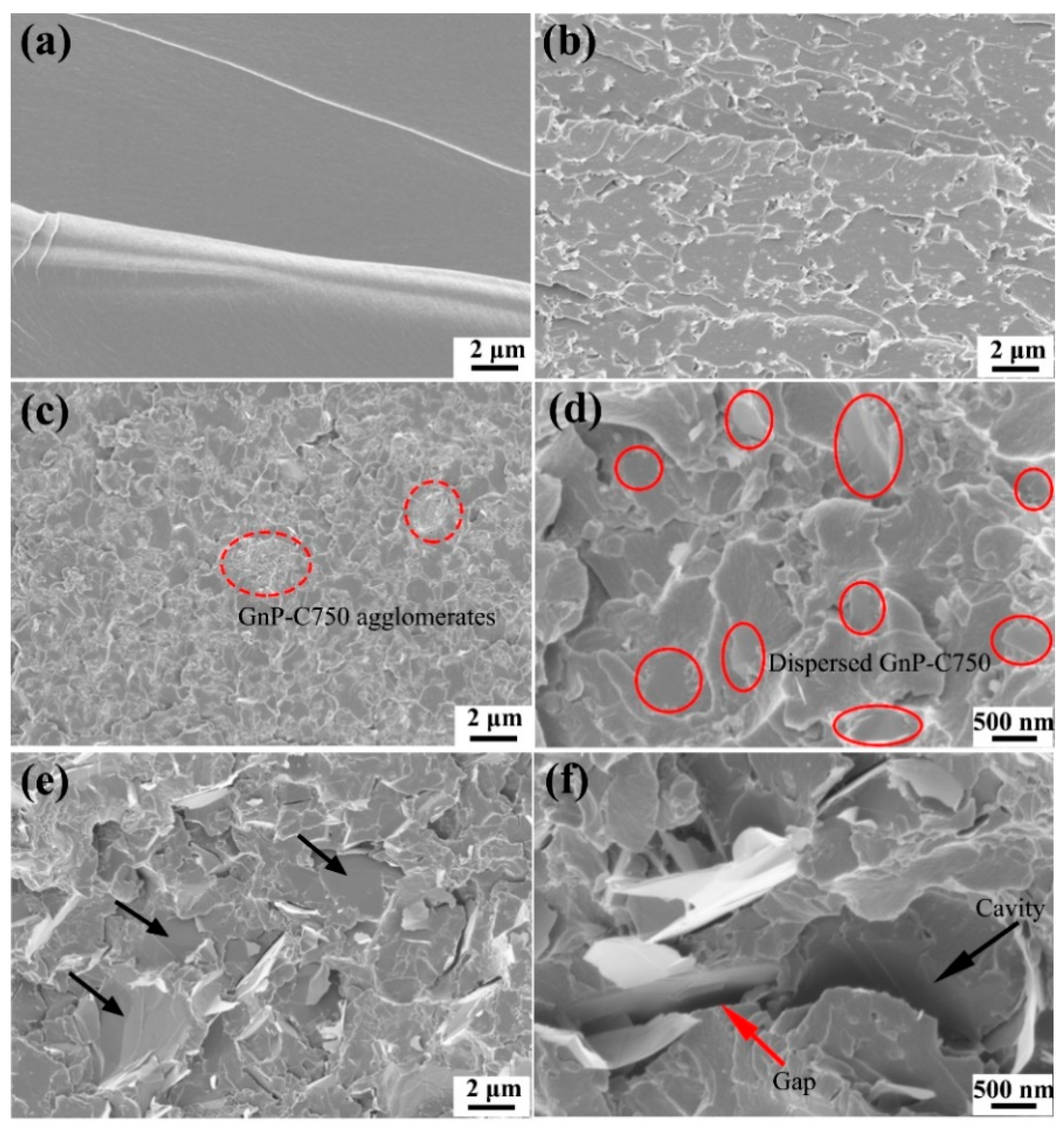
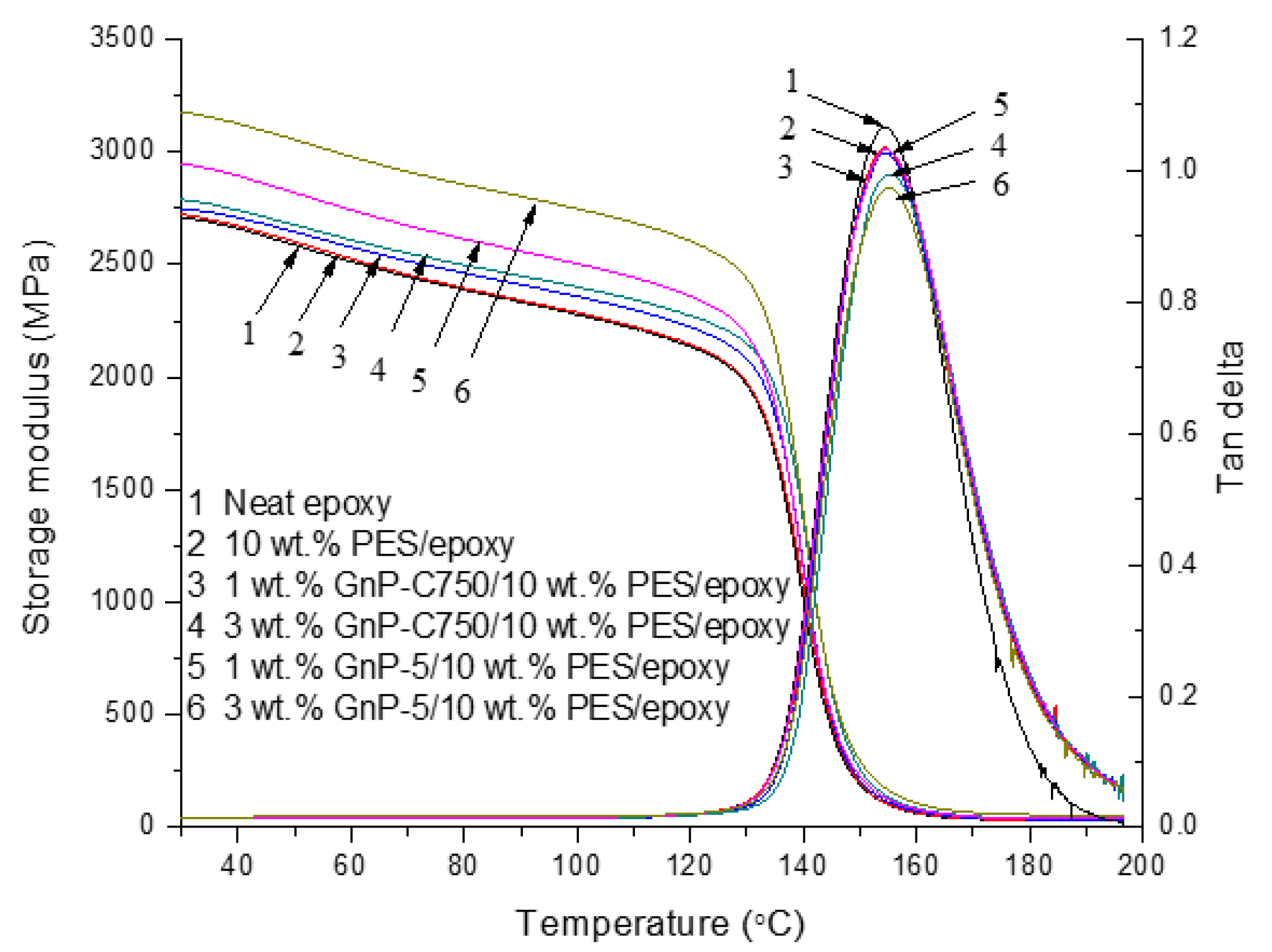
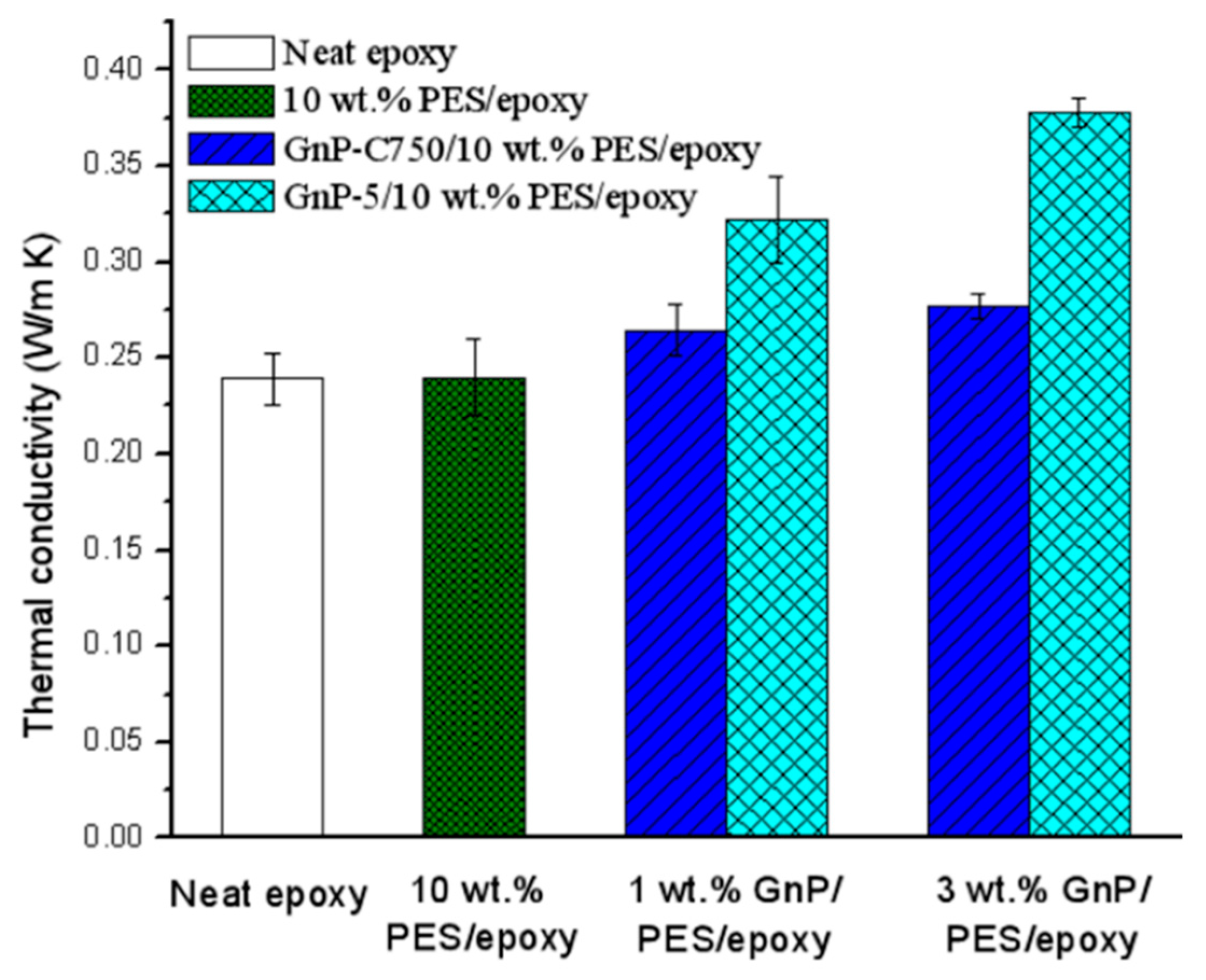
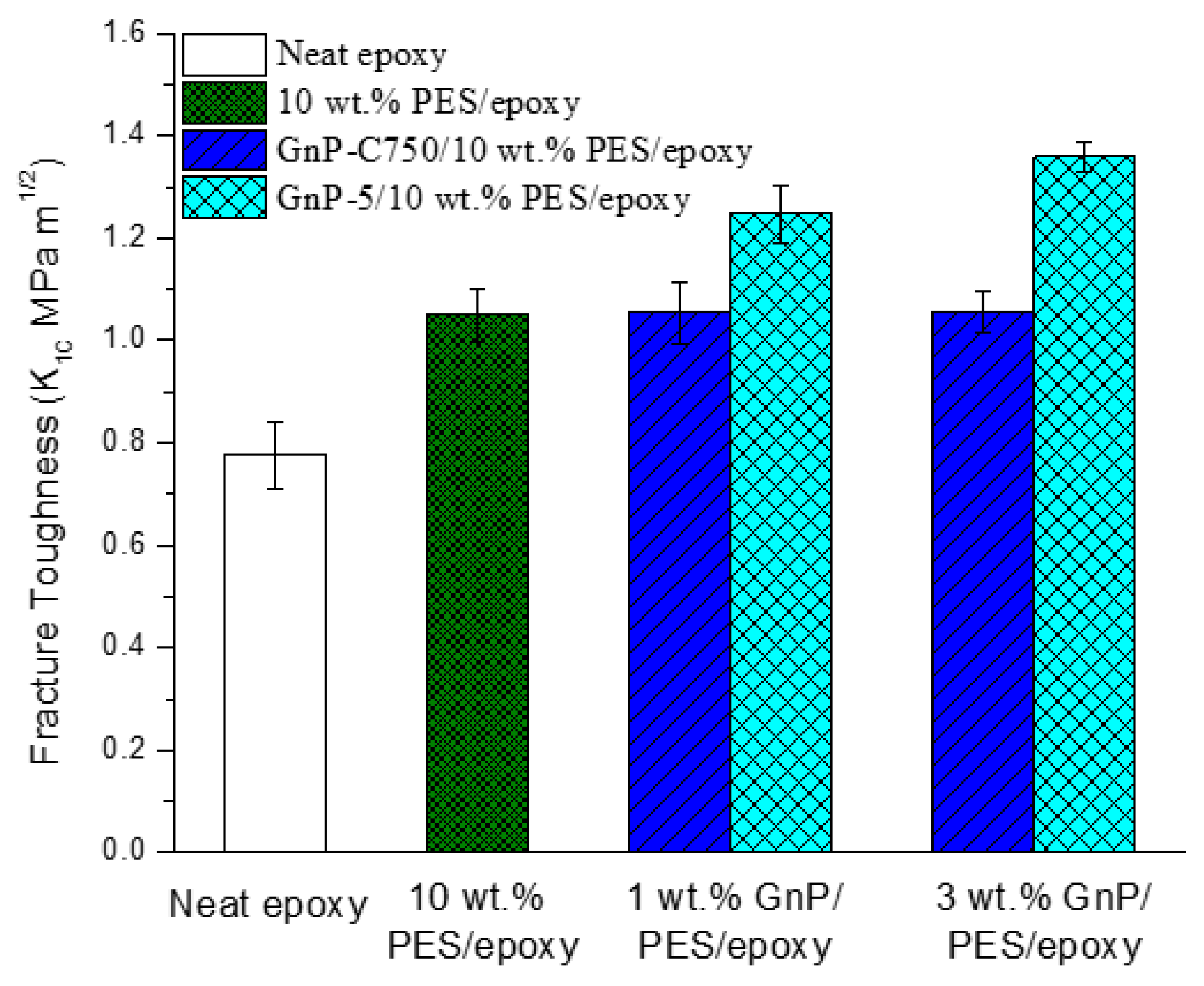

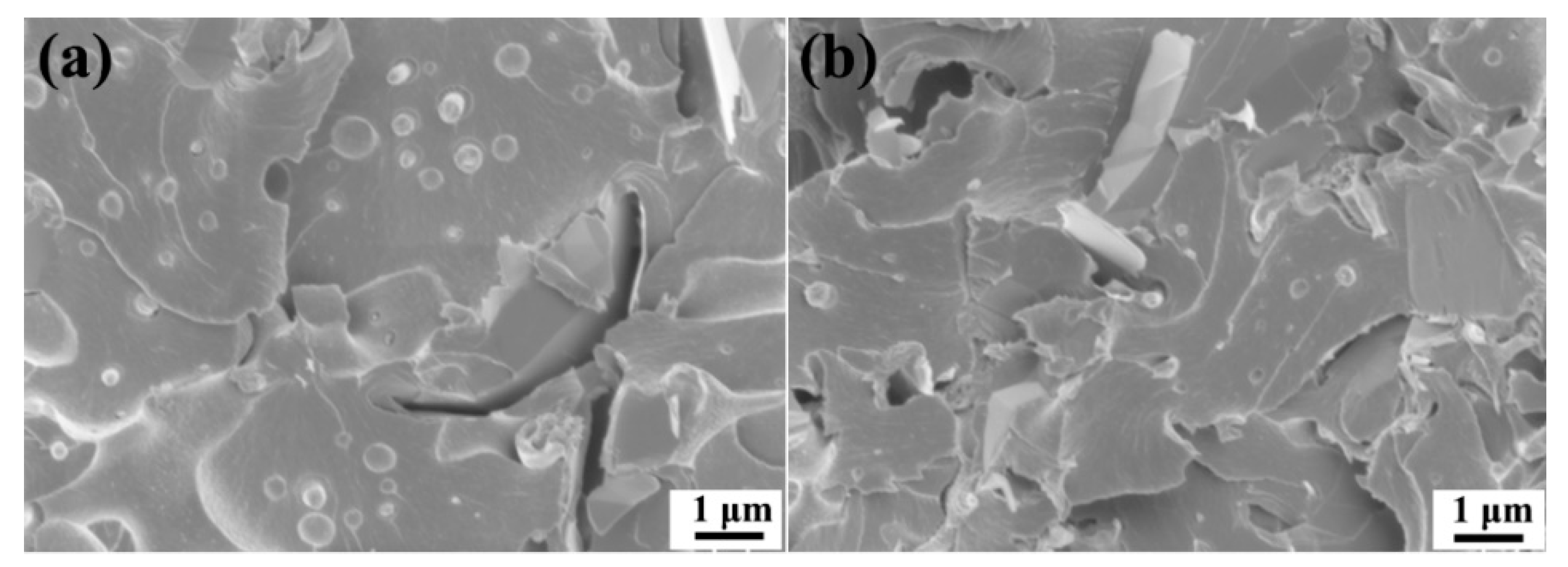
| Element Atomic (%) | C (%) | O (%) | N (%) | O/C (%) |
|---|---|---|---|---|
| GnP-C750 | 89.48 | 8.79 | 1.73 | 0.0982 |
| GnP-5 | 95.82 | 4.01 | 0.17 | 0.0418 |
| Specimen | Neat Epoxy | PES/Epoxy | GnP-C750/PES/Epoxy | GnP-5/PES/Epoxy | ||
|---|---|---|---|---|---|---|
| GnPs content | 0 wt % | 0 wt % | 1 wt % | 3 wt % | 1 wt % | 3 wt % |
| Storage modulus at 30 °C (GPa) | 2.71 | 2.72 | 2.75 | 2.79 | 2.95 | 3.18 |
| Tg (°C) | 154.3 | 154.6 | 154.7 | 155.3 | 154.8 | 155.5 |
| Filler Fraction | Modified Epoxy | Toughness (MPa m1/2) (Enhancements) | Tensile Modulus (GPa) (Enhancements) | Reference |
|---|---|---|---|---|
| MWCNTs (0.5 wt %) | PES (10.6 wt %)/epoxy | 2.02 (10.1%) | 4.80 (13.5%) | [38] |
| MWCNTs (1 wt %) | Polyamide (20 wt %)/epoxy | 1.10 (29.4%) | 2.38 (−0.4%) | [1] |
| Organoclay (1 wt %) | PES (5 wt %)/epoxy | 1.12 (43.6%) | 2.98 (3.5%) | [39] |
| GnP-5 (3 wt %) | PES (10 wt %)/epoxy | 1.36 (29.5%) | 4.31 (27.1%) | This work |
© 2018 by the authors. Licensee MDPI, Basel, Switzerland. This article is an open access article distributed under the terms and conditions of the Creative Commons Attribution (CC BY) license (http://creativecommons.org/licenses/by/4.0/).
Share and Cite
Wang, F.; Drzal, L.T. Development of Stiff, Tough and Conductive Composites by the Addition of Graphene Nanoplatelets to Polyethersulfone/Epoxy Composites. Materials 2018, 11, 2137. https://doi.org/10.3390/ma11112137
Wang F, Drzal LT. Development of Stiff, Tough and Conductive Composites by the Addition of Graphene Nanoplatelets to Polyethersulfone/Epoxy Composites. Materials. 2018; 11(11):2137. https://doi.org/10.3390/ma11112137
Chicago/Turabian StyleWang, Fuzhong, and Lawrence T. Drzal. 2018. "Development of Stiff, Tough and Conductive Composites by the Addition of Graphene Nanoplatelets to Polyethersulfone/Epoxy Composites" Materials 11, no. 11: 2137. https://doi.org/10.3390/ma11112137
APA StyleWang, F., & Drzal, L. T. (2018). Development of Stiff, Tough and Conductive Composites by the Addition of Graphene Nanoplatelets to Polyethersulfone/Epoxy Composites. Materials, 11(11), 2137. https://doi.org/10.3390/ma11112137




